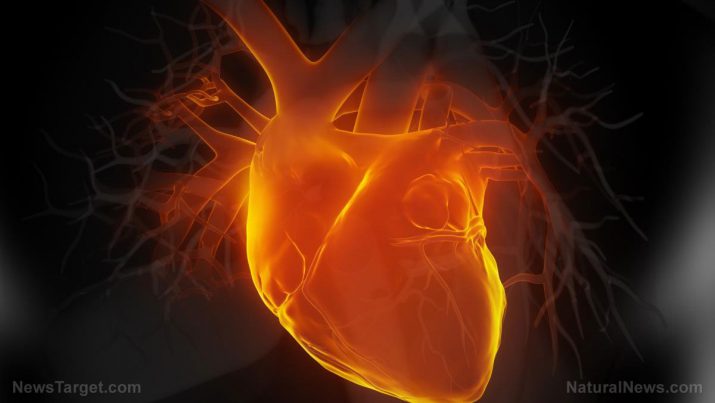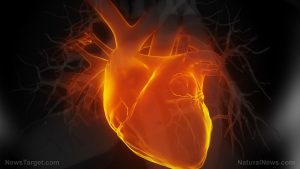
Accessory pathway — causes, side effects and treatments at NaturalPedia.com
Wednesday, December 20, 2017 by Rita Winters
http://www.naturalpedia.com/accessory-pathway-causes-side-effects-and-treatments-at-naturalpedia-com.html

Accessory pathway tachycardia, more commonly known as Wolff-Parkinson-White (WPW) syndrome, is characterized by an abnormal span of tissue, called the accessory pathway, connecting the atria and ventricles. This abnormal pathway is present at birth and results from the incomplete separation of the top from the bottom parts of the heart. Accessory pathway is an abnormality in the development of the electrical system of the heart that alters the cardiac cycle.
Normal heartbeats begin at the sinoatrial (SA) node found in the right atrium. From there, electical activity spreads to the right and left atria, which makes them contract. These impulses then travel to the atrioventricular (AV) node that allows the electric currents to go from the atria to the ventricles, and thus allow the ventricles to contract. This process is what defines a normal cardiac cycle, and is called normal tachycardia.
However, with an abnormal “wiring”, the accessory pathway directs these impulses from the SA node away from the AV node, which causes the heart to contract in an irregular fashion (tachyarrhythmia). To put it simply, an accessory pathway is somewhat of a “shortcut” that skips vital electrical nodes that facilitate normal heart beating.

Known side effects of accessory pathway
Accessory pathway tachycardia is often described as a rapid heart rate, or heart palpitations. People with accessory pathway tachycardia experience rapid heart rates infrequently, but some individuals may experience it once or twice a week or more. Some people do not exhibit symptoms, and abnormalities are only found from heart tests done for other purposes.
People with symptomatic accessory pathway tachycardia may experience chest pains, pulsations in the neck, shortness of breath, light-headedness, fatigue, sweating, passing out, and sometimes cardiac arrest. Infants may display side effects such as irritability, intolerance of feedings, history of not behaving normally for one to two days, and intercurrent febrile illness.
Body systems harmed by accessory pathway
Accessory pathway tachycardia mainly affects the heart, but may also affect other body systems including the respiratory system if complications arise from the sudden rapidness of heart rates.
Food items or nutrients that may prevent accessory pathway
Individuals who experience rapid heart rates from accessory pathway tachycardia should avoid items that contain caffeine, tobacco, alcohol, and pseudoephedrine (a nasal decongestant), as these items are known to increase heart rates further.
Experts also suggest a low-salt and low-cholesterol diet, and avoidance of sports that are too aggressive or too competitive. These include occupations that are “high-risk”, including professions in the army, police force, or airline pilot.
Treatments, management plans for accessory pathway
There are three main treatments for accessory pathway tachycardia:
- Vagal maneuvers – These techniques were designed to lower down electrical signals in your heart. One example is called the “Valsalva maneuver”, where you hold you breath and strain as if you’re on the toilet.
- Medication – Accessory pathway tachycardia can be treated by injection of adenosine if vagal maneuvers do not help.
- Cardioversion – This is a type of electric shock therapy that jump starts the heart back into a normal rhythm. These is done as a last resort when the abovementioned treatments do not work at all.
- Catheter ablation – This is a procedure that aims to destroy the extra part of the heart causing problems to the heart’s electrical system. It is effective in 95 percent of cases.
Where to learn more
- The IUD Mirena causes Tachycardia. Tachycardia can lead to death. Did I get your attention?
- 5 Toxic Protein Powder Ingredients
- Vaccine mechanism of harm exposed in Gardasil vaccine
- While insisting marijuana has no medicinal value whatsoever, government approves new drug derived from cannabis to treat multiple health conditions
- Monosodium glutamate (MSG), The Silent Killer Lurking in Your Kitchen Cabinets
Summary
Accessory pathway tachycardia is a congenital heart abnormality that causes sudden irregular heart rates.
Accessory pathway tachycardia is found from birth, but may not be detected if not symptoms arise.
Accessory pathway tachycardia is treatable through medication and medical procedures, but can be controlled with lifestyle changes.
Sources include:
Tagged Under: Tags: accessory pathway





